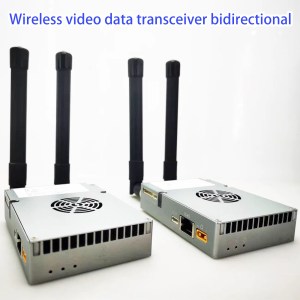Yuav ua li cas kom tau txais RSSI thiab SNR ntawm drone transmitter?
Cov Lus Qhia
Lo lus nug: I noted that the TX900 webpage does not send RSSI data to the flight controller; it will not trigger a failsafe action when the radio link is lost. Is there any way to work around this issue?
teb: RSSI wireless txuas cov xwm txheej cov ntaub ntawv xav tau cov neeg siv khoom (xws li davhlau controllers) kom manually xa AT cov lus txib kom tau txais nws. Nws tuaj yeem tau txais los ntawm ob txoj kev:
- Configure UART3 (data port 3) raws li AT command serial chaw nres nkoj, thiab tom qab ntawd xa AT cov lus txib los ntawm UART3 (D3) kom tau. https://ivcan.com/change-d3-from-transparent-serial-port-to-at-command/
- Hloov kho lub firmware version 1.5.1 los yog saum toj no, yog li ntawd yuav muaj ib qho ntxiv TCP neeg rau zaub mov sab hauv rau cov neeg siv khoom nkag los ntawm TCP xa AT cov lus txib kom tau txais cov xwm txheej wireless.
Here is the explanation from our engineer.
- Lub teeb LED yog siv los qhia txog kev sib txuas wireless (piv txwv li, yog tias qhov txuas wireless raug txiav tawm, lub teeb yuav tawm mus), and there is no dedicated external pin to notify the customer of flight control.
- Our core module has GPIO pins, but they are basically connected to LED lights. Our vcan1681 module also has such pins, but currently, it is also connected to LED lights.
- If you are willing to spend money on customization, we can customize a special one for you, and the external interface can be changed.
- When customers use our drone wireless video data links, they will definitely need to obtain air-side flight control information through the serial port or network port to the serial port.
- The general method is to add verification to the ground station software and flight control software to measure the reliability of the wireless link. Lub sijhawm no, you can completely sense the link quality and link disconnection events in the software, and then set the threshold in the software to alarm and handle it.
- That is to say, when the ground station software obtains the air system flight control information through our wireless link if the error rate exceeds a certain threshold, it can be considered that the wireless link has reached an unreliable threshold and needs to be processed. This is a common practice among Chinese drone companies.
Talking RSSI SNR for the below products
Lo lus nug: Can you develop a new model for me? It is easy to get RSSI and SNR?
Do you just need to get the real-time status of whether the wireless link is connected/disconnected? Or do we need to obtain even RSSI?
Because a GPIO can only identify two states: 0/1, it can only be used to indicate whether the wireless link is connected/disconnected, and cannot express the values of RSSI (the values of RSSI and SNR still need to be obtained through AT commands)
If you need us to actively report information such as RSSI and SNR in addition to the status of the link being connected/disconnected, then you must operate according to the customized project. You need to clearly describe your needs, docking interfaces, thiab lwm yam. (instead of In a simple sentence), so that we can evaluate the difficulty of developing customization and the ways to achieve it.
What is SNR and RSSI?
SNR (Signal-to-Noise Ratio) is a ratio-based metric that measures your signal in relation to the noise.SNR is made up of two values that are measured as a positive number between 0db and 120db, with the closer it is to 120db, the better: signal value and noise value, both of which are commonly reported in decibels (db).
covRSSI (Received signal strength indication) will look at the Signal (Also known as RSSI) first this value is measured in decibels from 0 (zero) rau -120 (minus 120) now when looking at this value the closer to 0 (zero) the stronger the signal is which means it’s better, typically voice networks require a -65db or better signal level while a data network requires -80db or better.
Because the signal is affected by the AP’s transmit power and antenna, as well as the client’s antenna, the normal range in a network would be -45db to -87db depending on power levels and design.
Signal strength (RSSI, “signal strength”, Signal/Noise Ratio). It is often preferable to concentrate on RSSI.
- RSSI -90 dBm: This signal is incredibly faint, and it is at the limit of what a receiver can receive.
- RSSI -67dBm indicates a rather strong signal.
- RSSI greater than -55dBm indicates a very strong signal.
- RSSI > -30dBm indicates that your sniffer is right adjacent to the emitter.
Failsafe
Lo lus nug: In case of signal loss from the operator, will FailSafe be activated?
teb: Failsafe is the function of the flight controller. We just provide signal transmission and transmit transparent data. What data do you give us, We transmit them for you.
Lo lus nug: Unless your receiver reports that the connection is lost, FailSafe is not activated.
teb: You can get the signal strength. Our wireless video data transmitter and receiver don’t have this function. I believe that the wireless image transmission of Chinese suppliers does not have this function, except that the drone set has already the failsafe function.






